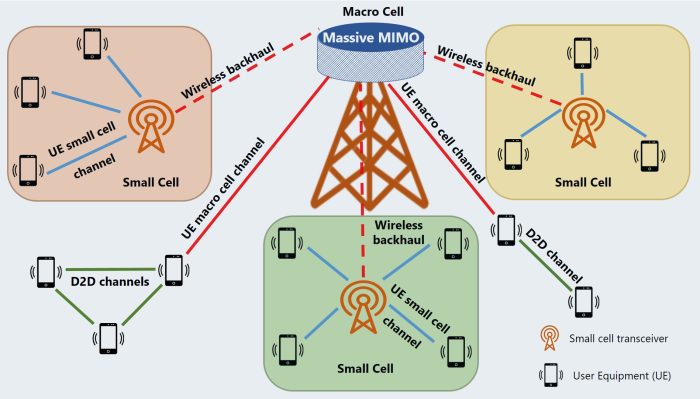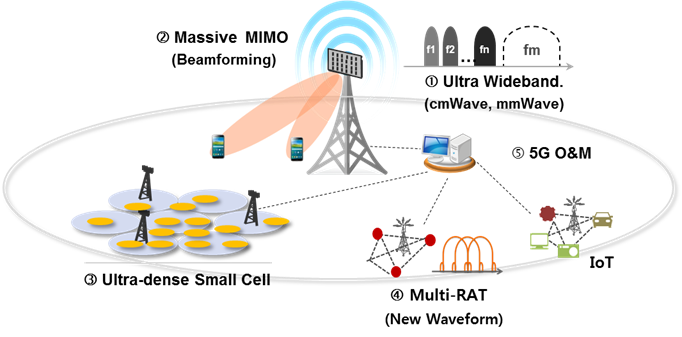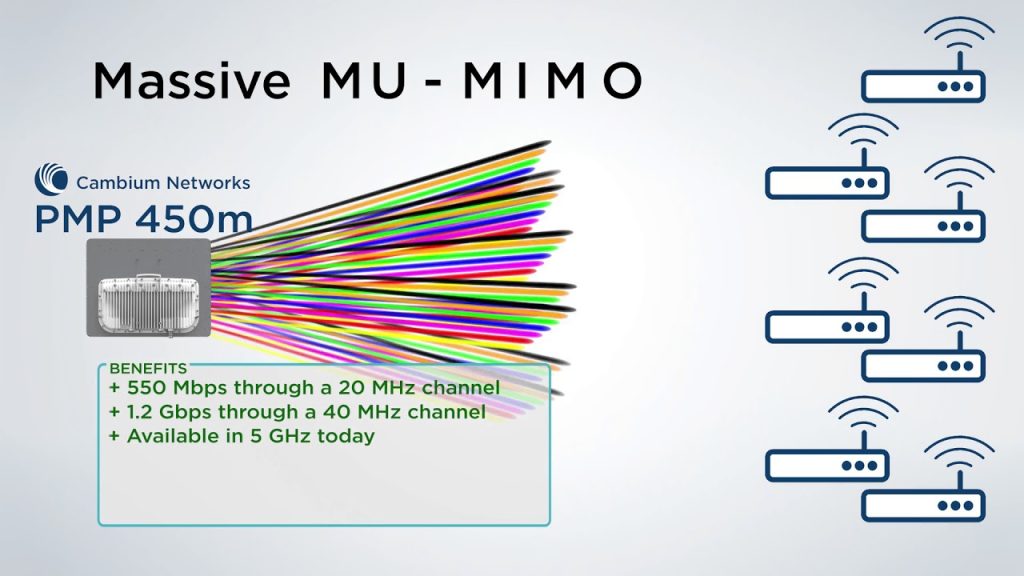The design and implementation of massive MIMO systems are fraught with tradeoffs that must be carefully navigated. One such tradeoff concerns the balance between spectral efficiency and energy efficiency, where achieving high spectral efficiency may lead to increased energy consumption. Conversely, optimizing for energy efficiency could result in reduced spectral efficiency.
However, this is not the only tradeoff at play in massive MIMO multicast transmission. Another critical factor is maintaining statistical channel state information (CSI) accuracy while also maximizing spectral efficiency. While using statistical CSI can reduce overhead costs, it may ultimately come at a cost of decreased spectral performance compared to using full CSI.
To achieve an optimal equilibrium amidst these competing factors in massive MIMO downlink transmission, resource allocation demands careful consideration. This involves judiciously distributing resources like power, time slots, and antennas among different users based on their individual channel conditions and QoS requirements.
Without fully grasping these multifarious tradeoffs inherent in designing efficient and effective massive MIMO systems tailored towards modern wireless communication networks’ needs would prove impossible. Only by skillfully balancing key variables such as spectral efficiency, energy consumption rates, CSI accuracy levels alongside meticulous resource allocation strategies can one optimize overall system performance across diverse applications within a given context of the vast world of Massive MIMO Systems!

Understanding Spectral Efficiency Trade-offs in Massive MIMO Multicast Transmission
Contents
- 1 Understanding Spectral Efficiency Trade-offs in Massive MIMO Multicast Transmission
- 2 Energy Efficiency and Spectral Efficiency Trade-off in Wireless Communication Networks
- 3 Optimal Resource Allocation for Trade-offs in Massive MIMO Downlink Transmission
- 4 The Role of CSI in Spectral Efficiency Trade-off in Cellular Networks
- 5 Approaches to Achieving Energy Efficiency-Spectral Efficiency Trade-off in Massive MIMO
- 6 Impact of Antenna Selection on Energy Efficiency and Spectral Efficiency Trade-off in Massive MIMO
- 7 Multi-objective Optimization for Achieving Trade-off between Energy Efficiency and Spectral Efficiency in MIMO Radio Systems.
The advent of 5G technology has revolutionized wireless communication, ushering in a new era of complexity and innovation. One such breakthrough is massive MIMO – a cutting-edge technique that harnesses the power of multiple antennas to transmit and receive data simultaneously. While this offers unparalleled spectral efficiency, there’s always a catch: energy consumption.
Indeed, the cost-benefit analysis between energy efficiency and spectral efficiency in cellular networks can be quite perplexing. Fortunately, savvy engineers can leverage precoding techniques to optimize resource allocation for optimal trade-offs.
But what about multicast transmission? This unique feature poses fresh challenges altogether when it comes to achieving optimal trade-offs between energy and spectral efficiency due to its group-specific beamforming requirements. Fear not; innovative approaches have been developed that carefully balance both objectives without compromising user experience or increasing overall network-wide energy consumption levels.
Ultimately, comprehending the intricate trade-off dynamics at play here is essential for maximizing network performance in 5G massive MIMO systems. By using efficient resource allocation techniques alongside appropriate precoding strategies, we can achieve this goal with aplomb!

Energy Efficiency and Spectral Efficiency Trade-off in Wireless Communication Networks
The perplexing issue of wireless communication networks lies in the quest for the perfect blend between energy efficiency (EE) and spectral efficiency (SE). This balance is pivotal as it affects power consumption, transmission quality, and overall network performance. An array of algorithms such as precoding and antenna selection techniques for massive MIMO systems have been put forth by researchers to achieve an optimal EE-SE equilibrium.
However, there exists a burstiness factor that also influences EE-SE trade-offs – channel state information (CSI). CSI offers substantial improvements to SE by reducing interference while minimizing power consumption. Nonetheless, obtaining accurate CSI demands immense computational resources which may exacerbate power use. Henceforth, exploration into approximation techniques that can strike a balance between accuracy and computation complexity is crucial.
To attain an optimal EE-SE trade-off, consideration must be given to various transmission scenarios like massive MIMO multicast transmission or downlink transmission. For instance, in multicast transmissions where multiple users receive data simultaneously from a single transmitter using beamforming techniques; optimizing both EE and SE becomes more challenging due to increased interference among receivers. Thus new optimization strategies are required to take into account these unique characteristics of different transmission scenarios in order to obtain an optimal EE-SE balance.
Optimal Resource Allocation for Trade-offs in Massive MIMO Downlink Transmission
Designing massive MIMO downlink transmission systems is a challenge that requires optimal resource allocation to balance efficiency and spectral efficiency tradeoffs. Power allocation plays a crucial role in this endeavor, which has led to the development of various power consumption models for 5G cellular networks aimed at optimizing energy-efficient (EE) and spectral efficient (SE) performance.
Multicast transmission with statistical CSI presents an exciting new technique that promises significant improvements in the efficiency tradeoff for massive MIMO systems. By exploiting the correlation between multiple users’ channels, multicast transmissions can considerably reduce transmit power while maintaining high SE levels. Studies have explored this approach’s EE-SE trade-off using different optimization techniques like convex programming and genetic algorithms.
Simulation results highlight how optimizing resource allocation based on both EE and SE objectives leads to remarkable system performance compared to traditional approaches focused solely on maximizing either metric alone. These findings emphasize the importance of considering both EE and SE objectives when designing massive MIMO downlink transmission systems. Additionally, they suggest future research efforts must focus on developing more sophisticated optimization techniques capable of balancing competing objectives simultaneously while accounting for practical constraints such as hardware limitations or channel estimation errors.
The Role of CSI in Spectral Efficiency Trade-off in Cellular Networks
The role of Channel State Information (CSI) in achieving the perfect balance between energy and spectral efficiency is critical, particularly in cellular networks. However, when it comes to multi-user MIMO systems with massive downlink transmission featuring hundreds of antennas, things get complicated. Accurately obtaining CSI becomes an insurmountable challenge due to errors resulting from circuit power consumption and Rayleigh fading.
Despite these difficulties, even imperfect CSI can be used for optimizing data rates while maintaining a balance between energy and spectral efficiency. Various studies have suggested algorithms that exploit partial or outdated CSI to find optimal solutions.
Antenna selection also plays a significant role in determining the trade-off between energy and spectral efficiency in massive MIMO systems. By choosing only a subset of antennas based on their channel quality, one can reduce circuit power consumption without compromising performance too much. However, this practice diminishes diversity gain which could lead to lower data rates if not done carefully.
In conclusion, achieving the perfect balance requires careful consideration of several factors such as resource allocation accuracy, antenna selection efficacy, as well as ensuring proper channel state information under constraints – especially for wireless networks that feature massive downlink transmission with MIMO technology. Multi-objective optimization techniques that consider conflicting objectives are useful for finding optimal solutions under these conditions.\n
Approaches to Achieving Energy Efficiency-Spectral Efficiency Trade-off in Massive MIMO
The attainment of the energy efficiency-spectral efficiency trade-off in massive MIMO can be approached through various methods, each with its own unique characteristics that contribute to system performance optimization. Multi-objective optimization is a popular method that involves defining an objective function that takes into account both energy and spectral efficiencies, and then finding the optimal solution that maximizes EE while maintaining a certain level of SE. This technique is versatile as it can be applied to varying scenarios like 5G wireless, cognitive radio networks, and wireless communication networks.
Another approach concerns low-complexity iterative algorithms based on statistical CSIT (channel state information at the transmitter). These algorithms aim to optimize system performance by adjusting parameters like transmit power budget, multiple access schemes, and antenna selection. Statistical CSIT-based techniques are more practical for large-scale MIMO systems with many antennas because they use statistical information rather than perfect knowledge of channel conditions.
Lastly, multi-user MIMO systems are another viable option for achieving the energy efficiency-spectral efficiency trade-off. In this scenario, multiple users share resources such as time slots or frequency bands in order to maximize overall system performance while balancing energy and spectral efficiencies. Through careful resource allocation using techniques such as beamforming or interference management among users, significant gains in both EE and SE can be achieved compared to traditional single-user transmission methods.
Impact of Antenna Selection on Energy Efficiency and Spectral Efficiency Trade-off in Massive MIMO
The optimization of 5G massive MIMO systems is a complex matter, fraught with difficulties and challenges. Antenna selection, in particular, is a critical component of this process – one that has the power to make or break the elusive SE-EE trade-off. Unfortunately, in downlink massive MIMO systems, base stations are limited to statistical CSI only; imperfect data at best. In light of such constraints, it becomes imperative to employ transmission strategies that can maximize system performance under these conditions.
Numerical simulations have revealed just how much antenna selection can impact both energy efficiency maximization and SE-EE trade-off optimization. When perfect instantaneous CSI is available for use in massive MIMO systems, selecting antennas based on higher channel gains generally leads to better outcomes. However, when dealing with imperfect CSI due to limited feedback or errors in channel estimation, such an approach may not always be effective.
This research was funded by an open access article focused on optimizing antenna selection for maximum SE and EE potential within 5G massive MIMO systems plagued by less-than-perfect CSI. The study proposed several algorithms based on numerical simulations that strategically select antennas according to their respective contributions towards either SE or EE while respecting constraints such as transmission power. These innovative solutions offer hope for BSs struggling with limitations imposed by inadequate instantaneous CSI data within their massive MIMO networks.
Multi-objective Optimization for Achieving Trade-off between Energy Efficiency and Spectral Efficiency in MIMO Radio Systems.
The technique of multi-objective optimization is a perplexing yet crucial approach in the realm of MIMO radio systems. The ultimate goal is to strike a balance between energy efficiency and spectral efficiency while considering factors such as non-orthogonal unicast and multicast transmission, high multicast power budgets, and the massive MIMO channel model. By delving deep into this intricate process, one can achieve adjustable and reasonable EE-SE tradeoffs that have the potential to enhance overall network performance.
One aspect that deserves special attention in multi-objective optimization is spectral efficiency optimization – an elusive concept that requires extensive research on statistical channel state information (CSI), multiuser MIMO systems, conventional MIMO systems, beamforming or precoding schemes for resource efficiency optimization techniques.
Another vital consideration when attempting an EE-SE tradeoff in massive MIMO networks lies in choosing between DMIMO versus CMIMO architectures. Recent studies suggest that DMIMOs may prove more energy efficient than CMIMOs due to their ability to harness distributed processing across multiple nodes within the network. However, much work remains to understand fully how different system architectures affect overall energy consumption levels.
Achieving successful EE-SE tradeoffs mandates meticulous attention to detail across several technical domains encompassing antenna selection strategies; approximation methods for estimating complex functions like the EE-SE curve; statistical modeling approaches for characterizing wireless channels; and resource allocation algorithms designed with these objectives explicitly in mind.


